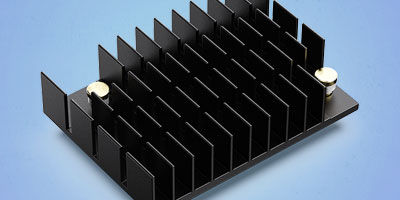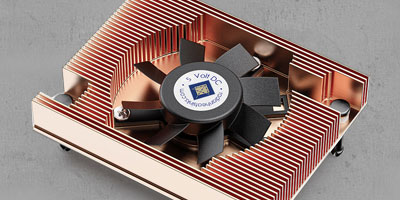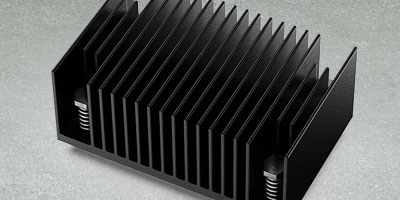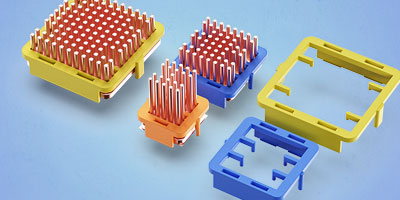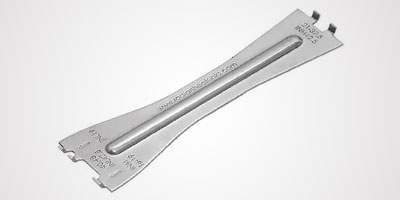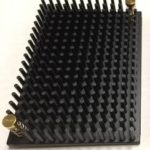 This page helps define the basic characteristics of a E-Coated Heatsink when the treatment is applied to the surface of heatsinks which are used to assist in the cooling of heat generating devices (typically electronic components). We will focus on thermal performance compared to an Anodized coating.
This page helps define the basic characteristics of a E-Coated Heatsink when the treatment is applied to the surface of heatsinks which are used to assist in the cooling of heat generating devices (typically electronic components). We will focus on thermal performance compared to an Anodized coating.
The process is similar to electro deposition of metals except E-Coating uses organic paint. The two main industry specifications are MIL-DTL-53084 and A-A-52474. After applying, E-Coating provides a consistent finish which is also corrosion resistant. The most common paint color is Black; although different colors may be specified since they can be used as a decorative finish. Parts need an electrically conductive surface in order to be E-Coated.
The process of E-Coating is broken up into 4 main steps.
- Pretreatment – Cleans and preps the part surfaces; may be done in several steps
- Electrocoat bath – Bath typically consists of 80-90% of deionized water and the remaining percentage are suspended paint solids (acrylic or epoxy). Paint solids consist of resin and pigment. Voltage typically controls the coating thickness
- Rinsing – Excess paint is rinsed off the part and recycled
- Baking – Cures the paint to promote cross-linking; typically, 20 minutes at 375F or 180F for low temperature paints
There are many advantages to using a E-Coated Heatsink:
- Only requires one coat for primer and color and can be used as a primer or undercoat for other finishes which adds improved adhesion and corrosion properties
- Compatible with liquid and powder topcoats
- Cost effective on a per part basis across all levels of production
- Part Coverage – Considered a wet process since the working parts are submerged into liquid, which results in the entire part is evenly coating by paint, including hard to reach areas
- Compared to Powder Coating, E-Coating is a thinner coating which does not significantly inhibit thermal properties. Typical thickness is 0.5 to 1.5 mils but could even go up to 5 mils if required
- Threads and holes do not require masking due to the thin coat
- Provides superior salt spray, humidity, cyclic corrosion resistance and resistance to many chemicals
- The coating is very hard and resistant to chipping, scratching or pealing
- Environmentally Friendly – Produces little or no HAPS (Hazardous Air pollutants), VOCs (Volatile Organic Compounds), and is RoHS, Reach, OSHA and EPA compliant.
- Assemblies can be coated as long as all surfaces are electrically conductive
- Due to the baking process parts must be able to survive the baking process
- Ultraviolet breakdown – E-Coated parts have low resistance to UV Light and is not typically used for outside environment applications
- Color – on the production line only one color can be used with the most common color being Black. Color changes are difficult and time consuming taking days to switch over
- Thermal impacts – Since E-Coating is an epoxy paint it inhibits thermal transfer however the impact is minimal since the final coating thickness is relatively thin. The rest of this paper is dedicated to the impact on heatsinks.
Typically, Aluminum should be Anodized for corrosion resistance and to color a part. However, in our experience a matte black finish is produced when anodizing die casted aluminum. The matte finish is due to the silicon content in the die cast aluminum. Further, since the silicon content is not homogenous the surface coloration can vary. If aesthetics is an important requirement then E-Coating should be considered. See Figure 1-3 below for a comparison of Anodization and E-Coating.
Since E-coating is a paint it is necessary to make a performance comparison between Anodized and E-Coating to determine if there is a thermal impact. Radian has performed a convection test using a 3U test bench, die casted aluminum 356.0 Pin fin heatsink mounted to a dummy heater block and attached thermocouples. Heater was set to 10W and Fan speed was varied from 200-800 LFM. A picture of the test setup can be seen in Figure 4 and Figure 5 test results following. Looking at the differences E-Coating does show an average of 1C higher than Anodization with a total impact of approximately 0.1 C/W.
Requirement for an E-Coated Heatsink should be communicated or specified on a drawing. The callout should simply be: E-Coating, Black
E-Coating should be considered if the following conditions are considered:
- Material is Die Casted Aluminum, 356.0
- Operating environment is indoors
- Cosmetics are important
- Thermal Impacts are acceptable
